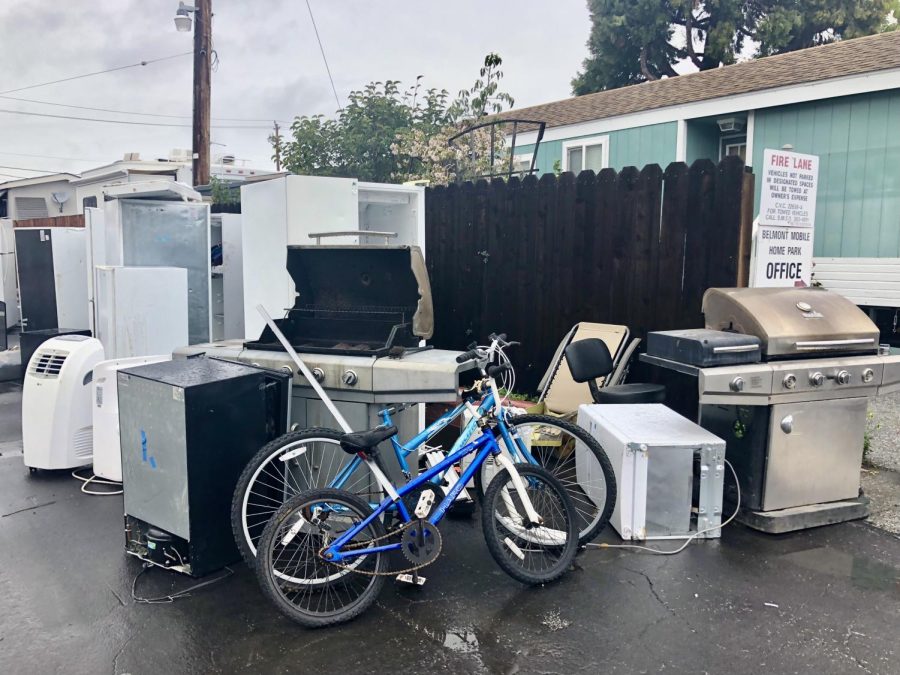
X: @lucyyas_


To view her portfolio, click here.
Twitter: @clecunningham


Residents, businesses, and community officials cope with impacts of storms that began on New Year's Eve
February 13, 2023
While many people celebrated New Year’s Eve with relaxing, rainy night-ins, Belmont and San Carlos’ emergency response teams were on call around the clock to manage the impacts of the biggest storm these cities had seen in years.
A eucalyptus tree falls on a city work truck as a result of high winds and excessive flooding.
Back in 2017, San Mateo County experienced a series of storms, but the storms that kicked off the start of 2023 may rival the winter of El Niño in 1997 and 1998, according to Peter Brown, the Public Works director of Belmont.
“We had to close Harbor and Old County because the whole underpass underneath the CalTrans tracks was fully underwater, and we had to rescue a few people that had driven their cars into the floodwaters,” Brown said.
The public works department of Belmont would receive more than 160 calls over the next two weeks after the first storm, but the city was prepared to be available for these upcoming storms and emergencies.
“After that first storm, we were better prepared. We had more resources, and public works and fire and police department staff ready to come in during extra hours and overnight,” Brown said.
As a preventative measure, in San Carlos, there are regular storm drain cleanouts in the summer and fall to manage potential flooding. However, no city was perfectly prepared for the bizarre circumstances that the first storm on New Year’s Eve presented.
“Certainly, that storm was larger than we expected, and seeing it take some of the damage was just unprecedented in terms of the amount of rain,” said San Carlos Mayor Adam Rak.
Despite the difficulties, emergency workers stepped up when the floods infiltrated residential streets and parks.
On San Juan Blvd., a mudslide on Jan. 14 resulting from the storm closed off the street for about two weeks while it was evaluated and repaired.
“Think of it as a sandcastle or something where if you move that mud at the street level, some root systems and other things could be impacted, and that would make the slide worse,” said Belmont Mayor Julia Mates.
In addition to residential areas, the floods closed off several parks in Belmont and San Carlos, like Twin Pines and Canyon Park, respectively. These open spaces closed because of downed and unstable trees and saturated, slippery soil that posed a threat to children and walkers. City social media amplified these dangers to the public and warned people not to enter the parks until it was safe.
“We even had a eucalyptus tree fall on a city work truck when they were out to inspect some other downed trees. So it was very impressive — the preparedness and the response from the Belmont city staff,” Brown said.
With damages adding up, federal funding went under consideration. As the storms were declared a state of emergency for California, this opened up resources from the Federal Emergency Management Agency (FEMA).
“We always try our best, and I think we’ve had a good track record of getting reimbursement under FEMA, and so we’re positive or hopeful that will happen again this time,” Brown said.
San Carlos explored the option of federal funding as well.
“Similar to Belmont, we have a limited number of public work staff. So, we have on-call contractors who we can bring on in case of emergency to address cleaning rock creeks or other things or if there is stuff that we can’t handle in-house. So there are certainly costs around that that we’ll be looking at,” Rak said.
Working with the county was also necessary for jurisdiction over properties like the Belmont Trailer Park and other county lands.
“The partnership that we have in this county where we all work together when we need to is something we should really uplift and talk about because I don’t know about other counties, but it is nice that when things like this happen, we kind of all work together, especially in those first few hours when it’s just crazy and hectic,” Mates said.
For the state of California, the abundance of rain made a dent in the drought, but not until there are more consistent rains and state operations will there be a systematic way to both prevent flooding and improve the drought. The Shasta and Oroville reservoirs — the biggest ones in the state — had noticeable improvements after the storms, but laws that require them to be open during the winter may have hindered their potential to maximize water storage.
“There are some antiquated laws on the books that are dictating how some of the state’s dams and water resources are managed, and those need some updating and revisiting. So that’s one thing that is difficult to balance, and until we get some significant revamping and changes in those dam operations, we’re not going to improve the situation,” Brown said.
Despite the lack of control over the drought from cities, public works teams in Belmont and San Carlos made a plan for damage repair in their respective communities.
“We have to prioritize which things need to be repaired first, and we’re also keeping track of all these things because the private property owner of the city is also eligible for federal and state emergency resources,” Brown said.
San Carlos was prepared to help any residents in need with the help of generous contributions from city staff.
“We had our Parks & Recreation team helping with the potential to have a shelter open if need be, but we didn’t need to use that, and some of them were also helping with sandbags. We had our trade services team working on manning the phones or answering phones if residents had concerns or issues or downed trees or things like that,” Rak said. “So the staff stepped up in terms of being able to all pitch in.”
Nearing the end of the storm, city officials like Brown did not foresee any persisting impact from the storm, but rather, as an opportunity to move forward and create stronger groundwork for future weather events.
“I don’t believe there’ll be any long-term impacts. I think all the damage that has happened is all reparable. But hopefully, both the city and its residents and its businesses keep moving and doing what we can to become more resilient and prepared,” Brown said.
Volunteers and workers help to replace the waterlogged flooring inside the Jazzercise building.
Businesses had high hopes for the new year, but the New Year’s Eve storm effectively shut those down, delaying their potential for success.
Businesses on the El Camino strip running between Belmont and San Carlos closed down, including Jazzercise, One Life Counseling Center, and Devil’s Canyon Brewery.
This posed several financial issues and dangers for the buildings, and in One Life’s case, delayed their weekly grocery donation program partnership with Second Harvest.
Serving about 150 families a week with groceries donated from Trader Joe’s and Costco, the program was put on hold due to an unstable fridge and freezer status.
“The hard part is we were kind of a sense of comfort, so they’ve had to change their routine. And also, it’s kind of a small community that we’ve built. So we had to disperse our community, which just breaks our hearts,” said Cindy Schwaab, the community outreach director at One Life.
Additionally, they had to pack everything up and put it in storage once the building flooded, which put a dent in their budget.
“That was seven, eight thousand dollars, and that that comes directly from us, which we would have loved to use to help people for low-cost therapy and for our clients,” Schwaab said.
Jazzercise, another business in San Carlos, had to close for three weeks. Between six-inch waters and destroyed flooring and sound system, lots of time and money were needed to get the building back into shape.
“We had folks on-site within hours of the flood because we were scheduled to have class, so I had a group of volunteers that helped us. The floor started floating away, and the underlayment became waterlogged,” said Sandy Basurto, the owner of the Jazzercise unit in San Carlos.
After hours of work, a flood came back later that day. Basurto knew that, at that point, there was nothing she could do until the next day.
“Water was coming through the mail slot underneath everything. We couldn’t stop water from coming in; sandbags were floating away. I mean, it was a river,” Basurto said.
On Jan. 1, the second and final cleanup started with cutting out drywall and checking for mildew. Future flooding was prevented by flex tape and cement-filled troughs in front of the door.
Basurto was hoping January would bring in more profit as people fulfilled their fitness new year’s resolutions, but the month was more of a loss than a gain, especially since 40% of the business had been lost during the COVID-19 pandemic. When the flood turned this into an unreachable goal, Basurto set her eyes on a new date.
“The first New Year was not very good, so my goal was Lunar New Year,” Basurto said.
Devil’s Canyon Brewing Company, another impacted business in San Carlos, had water rushing down Old County Road into the building. With the help of volunteers and staff, they worked for hours clearing the building out but had to face a challenge once more.
“So after seven, eight hours of cleaning it all out, it came right back in. And we were just standing there like ‘we can’t do anything about it’ because it has to go somewhere,” said Mackenzie Carpenter, the marketing and strategy director at Devil’s Canyon.
After their second and last flood, they officially closed down to start construction. Still, molded drywall, debris clearing, and canceled events did not come cheap.
“We don’t have flood insurance, so a lot of this is coming out of our pocket. But since the drain was blocked, we’re hoping we’ll be able to get some because that’s a different category on our insurance,” Carpenter said. “We’re hoping that will cover a little bit of it, but as of right now, it’s on us.”
Despite the drawbacks, one thing has been exceptionally helpful in speeding up Devil’s Canyon’s recovery: the community. Their own customers have even volunteered to do some of the cleanup work.
“We really couldn’t be luckier with our community around us,” Carpenter said.
This generous participation by San Carlos and Belmont residents seems to be a common thread between the businesses impacted by the flood.
In One Life’s case, they received calls from community members offering to “adopt” families and provide groceries while the organization got their donation program up and running again. Between this engagement and a positive attitude, Schwaab believes in a brighter future.
“We are going to be back, and we’re going to be stronger than ever. So I’m excited about that,” Schwaab said.
Basurto and other teachers were able to live stream classes for followers of Jazzercise, which kept them going. Volunteers were also a major part of cleaning up the facility, which may have even opened new possibilities.
“I really believe in this program. Otherwise, I wouldn’t be doing it. So I want to be really positive about this whole experience in that it’s an opportunity to rebuild. It’s an opportunity for us to be better,” Basurto said.
Mildew, rivers, and budgeting conflicts aside, water damage is no threat to businesses with strong ties to their community.
The storm on New Year’s Eve leaves many homes in the Belmont Trailer Park damaged.
The New Year began with a rocky start for residents across California when heavy rainfall on Dec. 31 left many with water damage. Right off of U.S. Highway 101 in Belmont, Calif., nearly four feet of water flooded a highly-affected area: the Belmont Trailer Park.
“It all happened so rapidly. It was raining in the morning, and by the afternoon, it was all flooded. All my stuff is full of water. I tried to rescue as much as possible,” said resident Vivi-Lili Castillo.
Bags full of Castillo’s water-damaged possessions sit in front of her home. She tried covering them with tarps, but it was futile against the incessant rain.
“I have a collection of expensive dolls I’ve been gathering for over 20 years. I was hoping to donate them to my home country of Peru,” Castillo said.
Twenty years of collecting is now down the drain. Castillo placed her beloved dolls in a trash bag outside; the water had damaged most of them beyond repair.
Inside Castillo’s trailer, the rest of her water-logged belongings, including furniture and personal items, are piled in the middle of the main room. The kitchen is damaged, and the floors are as well. Outside many other residents have dumped their damaged household appliances; TVs, refrigerators, and grills sit in the street.

“Nobody has insurance to fix the water damage here because insurance companies think this area is not good. I need to put stuff in storage, but it’s very expensive, so I don’t know how I will be able to do it,” Castillo said.
This is the situation many residents in the area face as their damaged objects begin to take up space in their homes. Directly after the flood, San Mateo County red-tagged the houses in the trailer park and offered hotel rooms for residents.
“San Mateo County provided a hotel room for the mobile home residents right after the flooding on New Year’s Eve,” Castillo said. “Now it is only offered for those with serious health conditions.”
When a home is red-tagged after a natural disaster, residents can only repair it once they consult with county officials. Mobile home residents with severe water damage will have to follow through with this process.
Despite the possibility of further rainfall, some residents chose to remain in the affected area. For residents like Philip Duffy, moving to a hotel room was too impractical.
“My wife and I didn’t avail ourselves of these resources offered because we both work, so it was more convenient to stay here,” Duffy said.
Duffy’s trailer managed to stay primarily dry. Like some others in the park, his trailer is elevated a few feet off the ground. This minimized the water damage in their homes.
“Luckily, our trailer is 2 ½ ft above the ground, so only our side room and laundry room were flooded,” Duffy said.
The reason the mobile home park was so affected could have stemmed from multiple factors: the nearby river, the storm drains, and the pipes. Castillo believes it is crucial to get to the root of this issue to prevent flooding in the future.
“I’ve heard many different opinions explaining why it flooded here. Some say it’s the Belmont Creek or that the pipes were broken. It could be the water running off the hills from Belmont. With all these different opinions, it is difficult to know what could help this area,” Castillo said.
Philip Scott, a fellow resident, believes the Belmont river, about 900 feet from the mobile home park, was a leading contributor to the flooding in the area.
“When Belmont Creek overflows its crest, it comes flooding into the mobile home park. The storm drains also backed up, especially due to the high tide in the Bay,” Scott said.
The stormwater in the area typically comes down from Twin Pines Park into the Belmont Creek through a culvert under El Camino Real. Through this culvert, the water flows all the way down to the mobile home park.
While residents across the Bay Area attempted to use sub pumps and water vacuums to minimize the flooding in their homes, this was impossible at the mobile home park.
“There was storm after storm coming down on us. Some people tried to mitigate the floating with sub pumps, but with the high tide, we were all like, ‘forget about it,'” Scott said.
After the flooding, the residents in the area received swift aid from county emergency services and the American Red Cross. The latter set up a shelter for those affected residents at the San Mateo County Fairground. The shelter provided the residents with a place to sleep, meals, and showers.
“The Red Cross came immediately, and the ownership and management service of the mobile park, too. The county emergency services were very helpful,” Duffy said.
Despite this support and assistance, mobile home park residents are still grappling with the aftermath of the flooding. They hope conditions will improve as the rainfall subsides, and they can begin to recover and find stability.
“This continues to be a low point for us – both geographically and psychologically,” Duffy said.


